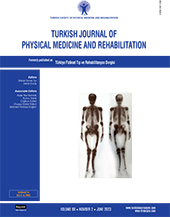Phonophoresis treatment of subacromial impingement syndrome: Pulsed or continuous: A randomized-controlled clinical trial
2 Department of Physical Medicine and Rehabilitation, Gazi University Faculty of Health Sciences, Ankara, Türkiye
3 Department of Physical Medicine and Rehabilitation, Adana City Hospital Training and Research Hospital, Adana, Türkiye DOI : 10.5606/tftrd.2023.10996 Objectives: This study aims to compare the effectiveness of pulsed and continuous modes of therapeutic ultrasound (US) for phonophoresis in the treatment of subacromial impingement syndrome (SAIS).
Patients and methods: Between April 2019 and January 2021, a total of 66 patients with SAIS (17 males, 49 females; mean age: 48.2±8.6 years; range, 19 to 64 years) were included. The patients were randomized to the phonophoresis with continuous mode group (n=22), phonophoresis with pulsed mode group (n=22), and phonophoresis with sham US group (n=22). Five grams of ibuprofen phonophoresis was applied in five sessions per week for three weeks for all groups. Primary outcomes were pain intensity as assessed by the Visual Analog Scale (VAS) and shoulder functions by the short version of Disabilities of the Arm, Shoulder and Hand Questionnaire (QuickDASH). The secondary outcome was the quality of life as assessed by the Nottingham Health Profile (NHP). All patients were evaluated at pre-treatment, post-treatment, and at three months after the end of the treatment.
Results: There was a significant improvement in pain during activity, shoulder function, and quality of life after treatment in phonophoresis with continuous and pulsed modes compared to phonophoresis with sham US (p<0.05). Phonophoresis with continuous mode was superior to other groups in reducing pain at rest (p<0.05). Changes between pre-treatment and the three-month follow-up showed a significant improvement in pain during activity and shoulder functions in phonophoresis with continuous and pulsed modes, compared to phonophoresis with sham US (p<0.05). Phonophoresis with pulsed mode was more effective than the other interventions in improving quality of life during the same period (p<0.05).
Conclusion: Despite a significant change in phonophoresis with continuous and pulsed modes, it is more pronounced for rest pain in the early period in continuous mode and for quality of life during follow-up in pulsed mode.
Keywords : Continuous mode, phonophoresis, pulsed mode, subacromial impingement syndrome

















